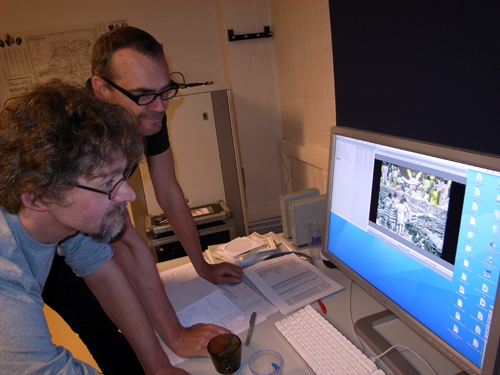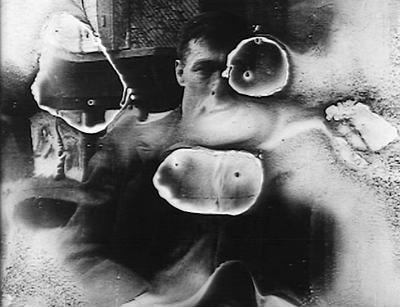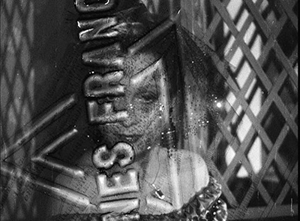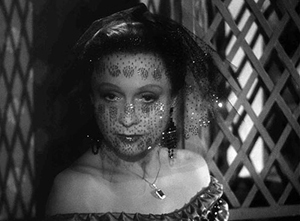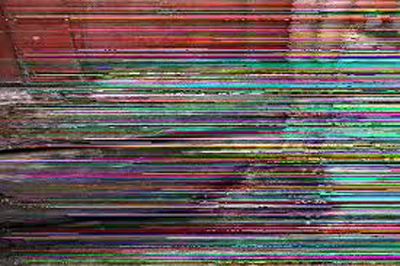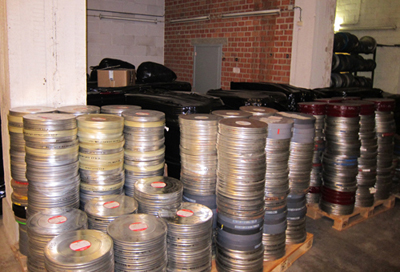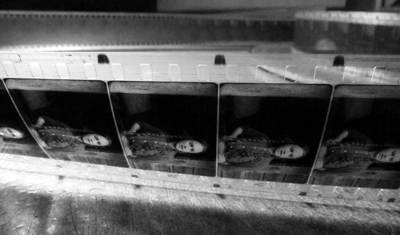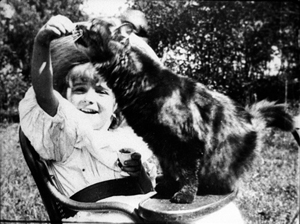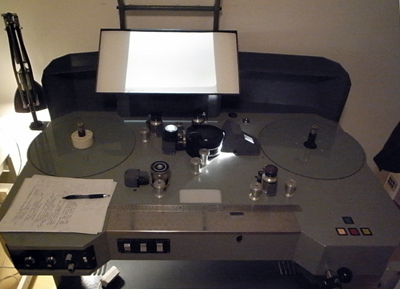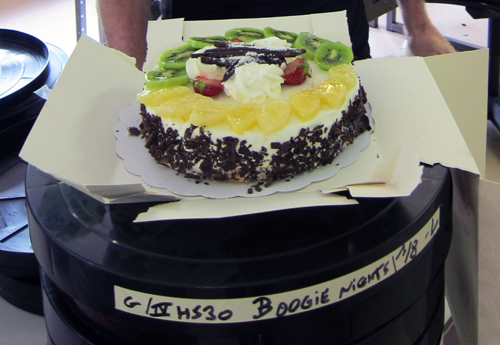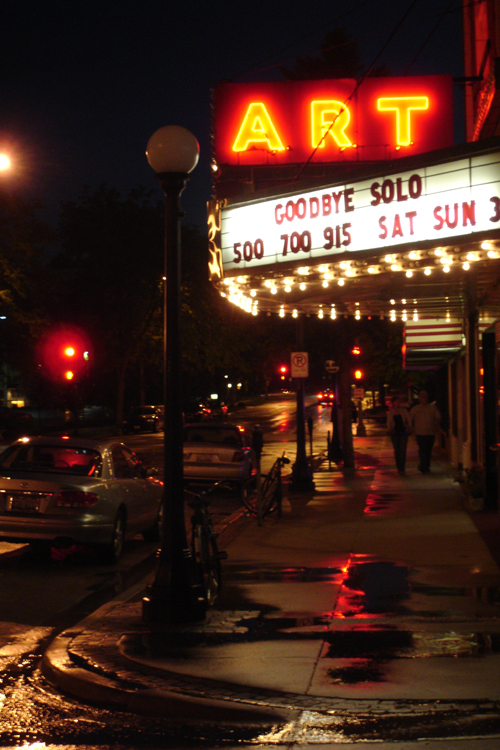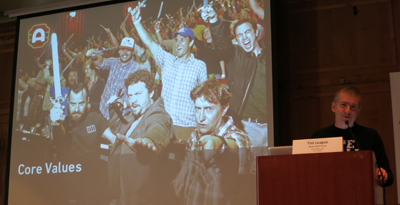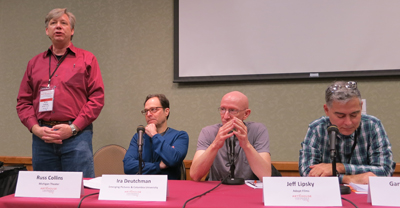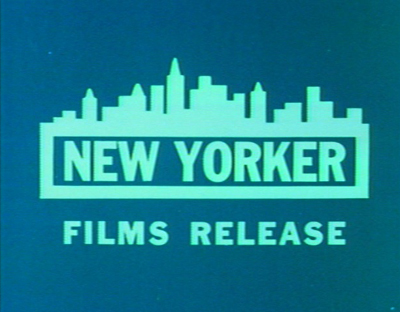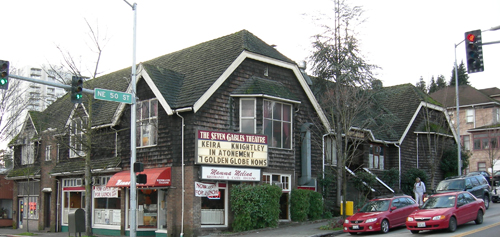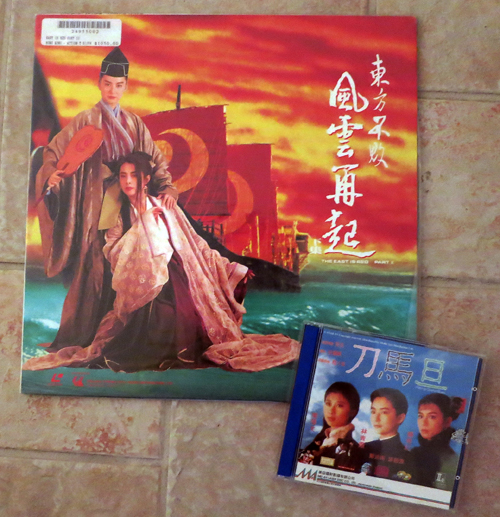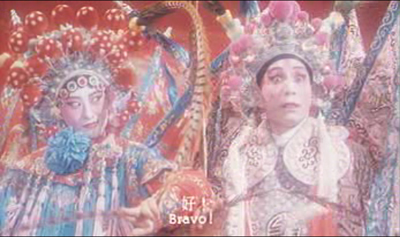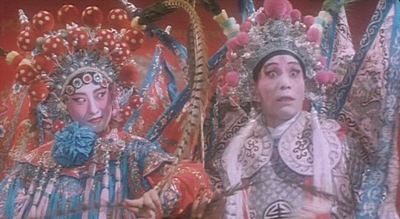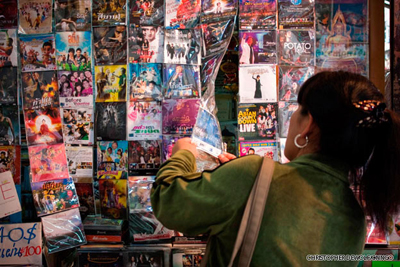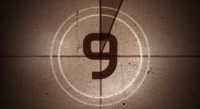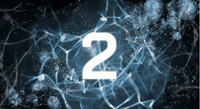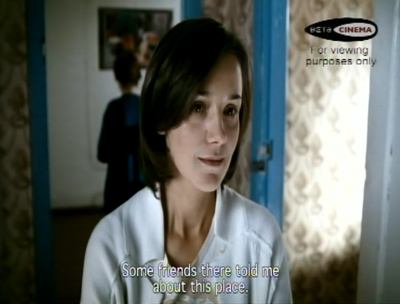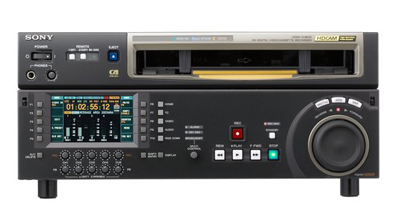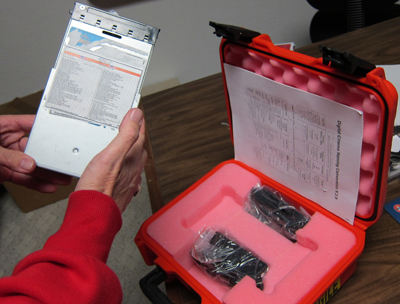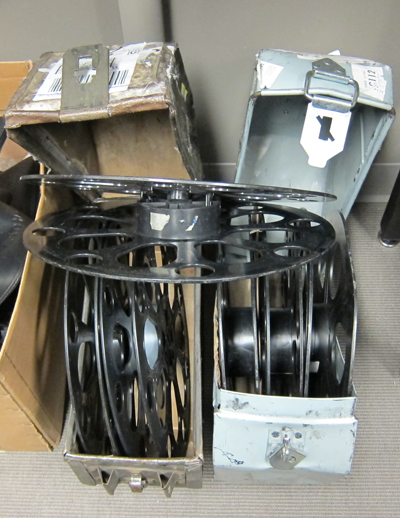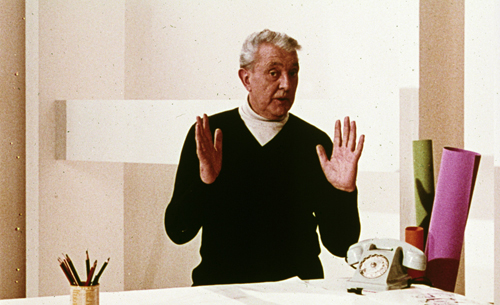Archive for the 'PANDORA’S DIGITAL BOX: The Blog Series' Category
Pandora’s digital box: Pix and pixels
Peter Rotsaert and Vico De Vocht examine a digital version of a silent film at the Brussels Cinematek.
DB here:
Today Dawson City, in the Yukon Territory of Canada, has fewer than two thousand people, but in the 1890s tens of thousands passed through in search of gold. Movies came along too, but the remoteness of the place made it the end of the line for most prints. Many were stored in the basement of the Carnegie Library. In 1929, an enterprising bank worker shifted them to an abandoned swimming pool. The stacks of films were covered with planks, and they were in turn covered by earth, so the films were buried in the permafrost. The surface became an ice hockey rink.
In 1978, builders discovered the film cache. Sam Kula, then an archivist at the National Archives of Canada, stored the films temporarily in an ice house. The painstaking process of checking each reel began. Eventually the US Library of Congress was brought in because most of the 507 reels discovered were American. Among the finds were a Harold Lloyd short, a great deal of news footage, and a rich array of serials starring heroines of the 1910s.
Wellington, New Zealand, was another terminus for American movies during the old days. In 2009, a film preservationist from the Academy of Motion Picture Arts and Sciences learned that the New Zealand Film Archive held a lode of Hollywood films. The collection, reviewed here, includes many Westerns and Christie comedies, along with John Ford’s supposedly lost Upstream (1927). The restored Upstream played in festivals and special screenings during 2010 and 2011. Five American archives have been involved in restoring the seventy-five titles selected for repatriation.
Whatever the merits of the films revealed—literally unearthed, in the Dawson instance—discoveries like these are signs of hope. Who knows how much more of our film heritage remains to be rediscovered? For this reason, George Eastman House archivist Paolo Cherchi Usai prefers to list a film not as “lost” but rather as “not yet found.”
Given such discoveries, the archivists will set to work creating usable and enduring versions. But today such a task is much harder. Soon most of the films we make and show will not exist on photochemical stock. They’ll be digital files, and they need to be kept securely. But how?
Will today’s typhoon of ones and zeroes rip away our analog past? Will there ever be a digital Dawson City, a stockpile of files of lost movies? It seems likely that digital projection has, in unintended and unexpected ways, put the history of film in jeopardy.
Digital restoration: A success story
Nitrate decomposition; from Bill Morrison’s Decasia: The State of Decay (2004).
Of the tens of thousands of feature films produced worldwide in the silent era, approximately ten per cent survive.
Jan-Christopher Horak, Director, UCLA Film and Television Archive
The archives I’m speaking of are either public ones, like the Library of Congress, or privately supported ones like Eastman House and the Museum of Modern Art. These and hundreds of smaller archives are nonprofit institutions charged with protecting images and sounds we’ve deemed of cultural value. By contrast, a studio-based archive aims to maintain the firm’s investment in its property. Often studios deposit films of historical importance at nonprofit archives; some countries require by law that copies of films circulated there be deposited in the national archive. Both sorts of archives have done excellent work, but I’ll be talking largely of the nonprofit ones, which often receive films by donation, deposit, purchase, or accident.
Archivists distinguish between conserving and preserving. You conserve a film by taking it into the archive and storing it safely in temperature-and-humidity controlled vaults. You preserve it by cleaning and patching it, and if necessary transferring it to a more stable medium. Restoration, which is the archival task most visible to the film-loving public, goes further. It involves working to bring the film back to something like its original state.
Before the 1970s, archives conserved and preserved, but seldom restored. Archivists at public institutions balanced two duties: keeping films safe for the future and screening them for the public and researchers. Like art museums, archives guarded treasures while putting some of them on display.
Most often, archives preserved their material by making the best possible copies. A big part of the job was migrating films from one format to another. For example, some early American film companies copyrighted their product by submitting rolls of paper on which each frame of film had been printed. These “paper prints” had to be transferred, frame by frame, to motion-picture film. Likewise, films surviving only in rare formats, like 9.5mm, 22mm, and 28mm, had to be transferred to 35mm so they could be run on standard equipment. Tinted films on nitrate were reprinted on black and white safety film. 16mm films might be blown up to 35mm, and 35mm might be reduced to 16mm for circulation to schools, libraries, and film clubs.
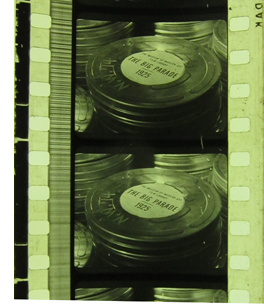 Most famously, thousands of films in archive collections exist on nitrate stock. That was the professional standard before 1950 or so, when the industry abandoned it. Not only did nitrate film have a habit of exploding or catching fire, but it tended to decompose. Experimental filmmakers have found a sinister beauty in ruined footage, but archivists organized for funding to help transfer their collections to acetate. Then archivists learned that some acetate prints degenerated into a vinegary, contagious vapor. So migration to a new, polyester-based stock became necessary.
Most famously, thousands of films in archive collections exist on nitrate stock. That was the professional standard before 1950 or so, when the industry abandoned it. Not only did nitrate film have a habit of exploding or catching fire, but it tended to decompose. Experimental filmmakers have found a sinister beauty in ruined footage, but archivists organized for funding to help transfer their collections to acetate. Then archivists learned that some acetate prints degenerated into a vinegary, contagious vapor. So migration to a new, polyester-based stock became necessary.
Preservation, simply keeping films alive in long-lasting formats, remained central to archives. In the 1970s a number of archivists also began restoring films. For example, most silent feature films were released in tinted and toned prints, but many copies survived only in black-and white. Restorers, guided by surviving paper records, aimed to create prints that approximated the original color schemes.
Restorers naturally faced decisions about what would count as an original. In 1989 there were six different versions of Mr. Smith Goes to Washington, running from 119 minutes to 132 minutes. In uncertain cases, records of running times and postproduction work helped identify what was missing. If the footage couldn’t be found, still photos or even a blank screen might cover the gaps, as in restorations of Greed and the 1954 A Star Is Born. A musical score helped researchers measure how much footage from the original Metropolis remained to be found.
With the rise of cable television and home video, studios’ film libraries became more valuable. Ted Turner, owner of the MGM, Warner, and RKO libraries, was blamed for “colorizing” some classics for his cable channels, but at the same time he invested in restoring a great many of them. Other firms followed suit. Gone with the Wind and Disney perennials were reworked for cable and VHS release.
The 1980s and 1990s became the great age of restorations. Audiences were reintroduced to Napoleon, Becky Sharp, Lawrence of Arabia, and Vertigo. Kevin Brownlow and David Gill, working with Thames Television, reissued silent classics, with new scores by Carl Davis. Most of the era’s restorations wound up on video platforms. Today Turner Classic Movies is our great display case for studio and off-Hollywood restorations; it’s the closest thing we have to a Citizen’s Film Library.
At first, restoration was a photochemical affair. Every major archive employed experts in rephotography and lab work who knew how to optimize the look of a print. Archivists like Noël Desmet collected information about properties of old film stocks and tinting dyes. Faded films could be reprinted through filters that might bring back some of the old snap. The look of old films was much improved by wet-gate printing, which bathed the frames in a liquid that masked scratches on the base or emulsion.
But not much could be done about the blotchy nitrate decay that might invade a scene, or the dirt and dust that earlier copies of the film bequeathed to the current one. And those films for which no original negative could be found, including Citizen Kane and Singin’ in the Rain, would always be seen as the shadow of a shadow—new copies pulled from earlier, perhaps shabby ones.
The upside was that as long as you kept your source prints and your restorations on 35mm film stock in a cool, dry place, you had material that would last over 100 years. Some day you might find better tools for improving what you had.
That day came fairly soon. The Disney company had a steady income from theatrical and video re-releases of its animation classics, and a 1990 reissue of Fantasia employed some video-paint work to correct flaws in the frames. Snow White and the Seven Dwarfs was then given high-resolution treatment. Dust-busting and color adjustments were made frame by frame. Re-released in 1993, Snow White was the first feature to be restored digitally.
Since then, digital fixups have become a standard method for archival restoration. Footage is scanned into a file at 2K or 4K resolution. Either manually or automatically, the software can correct for jumpy or shaky imagery, do dust-busting, erase scratches, and balance exposure, contrast, and other factors. It can interpolate image areas in order to correct damages in the frame, and it can add tinting or toning. The finished files may then be saved as files or scanned back onto film, as Snow White was. You can see an example from the newly restored Marcel Carné film, Children of Paradise (Les Enfants du paradis).
Soon most restorations are likely to be finished and screened on digital formats, with virtually no 35mm prints circulating.
Born-digital, born-again digital?
Decay of digital imagery, from Creative Applications.
The preservation of born-digital films is going to be the greatest challenge ever to face archivists.
Margaret Bodde, Executive Director of the Film Foundation
The new magical software has sometimes led to over-restoration. Grain has too often been polished out, creating a plastic sheen. Still, today no archivist can avoid using the new toolkit. The sadder story involves not restoration but conservation and preservation. A civilian might think: That’s simple. Just save film on film and digital on digital. But things are more complicated than that.
Let’s start with a movie like The Girl with the Dragon Tattoo, which was shot with digital capture. After production and post-production, it was made available to theatres as both a Digital Cinema Package (that batch of files on a hard drive) and some 35mm prints. But there are several digital versions of the movie.
Digital source material. The original sound and image “content” may be captured in specific formats, either tape-based or file-based. Those formats can vary a lot among themselves. The Girl with the Dragon Tattoo, for example, was shot with the Red One camera on the company’s proprietary format R3D. Other cameras don’t use that format. So the footage was converted to other sorts of files for viewing and postproduction work.
Any major film nowadays is likely to use many digital video and audio formats. All these assets are usually stored in the distributor’s vaults.
The Digital Source Master (DSM or DCM). This is the master copy of the finished film, somewhat comparable to a 35mm film negative. It can be in any format selected by the filmmakers. It’s the basis of the distribution master, the home video master, and a master version for archival storage.
The Digital Cinema Distribution Master (DCDM), in formats determined by the Digital Cinema Initiatives. This is the finished film unencrypted and uncompressed, providing “content” at 2K and/or 4K resolution. Roughly speaking, this is the digital counterpart of a 35mm release print.
The Digital Cinema Package (DCP). This is the film compressed and encrypted for theatrical playback. It’s roughly comparable to the delivery of a 35mm print on shipping reels.
The Digital Cinema Distribution Master as played (DCDM*) Once the DCP files are opened and decompressed, they yield image and sound identical to what’s encoded on the DCDM. The DCDM*’s place in the system is somewhat parallel to the projection of a 35mm print from platters.
Eventually, The Girl will show up on the optical disc formats DVD and Blu-ray, not to mention streaming video, cable transmission, and web-based platforms. (Actually, it’s probably already available for Darknet download.)
Many studio films are housed in nonprofit archives too, and until recently those movies have been deposited and stored as analogue copies. But what will those institutions now keep? There are only three minimally acceptable formats: the uncompressed and unencrypted DCDM, the DCP, and a 35mm print. Suppose your film archive is lucky enough to receive both a DCP and a 35mm print of The Girl.
First, how do you access the DCP files? A DCP is typically encrypted to block piracy. When The Girl played theatres digitally, each exhibitor was provided an alphanumeric password that would open the files for loading into the theatre’s server. By the time you the archivist get the files, that key may have expired or been lost. Without the key, the DCP is useless.
Then there’s the matter of storage. The 35 print of The Girl can simply be passively conserved, following the motto, “Store and ignore.” But all digital material, no matter how minor, requires proactive preservation. The future for digital storage is constant migration.
Archivists estimate the life of any digital platform to be less than ten years, sometimes less than five. All hard drives fail sooner or later, and they need to be run periodically to lubricate themselves. Tape degradation can be quite quick; one expert found that 40 % of tapes from digital intermediate houses had missing frames or corrupted data. Most of the tapes were only nine months old.
Moreover, hardware and software are constantly changing. One archivist estimates that over one hundred video playback systems have come and gone over the last sixty years. Archives currently recognize over two dozen video formats and over a dozen audio ones.
Periodically, then, the DCP files of The Girl will have to be checked for corruption and transferred to another tape or hard drive and eventually to another digital format. Such maintenance takes time; shifting a terabyte of data from one system to another may need at least three or four hours. Ideally, you’d want several copies for backup, and you’d want to store them in different locations.
There are hundreds of other films like The Girl awaiting processing at major archives. About 600-900 feature films are produced in the US each year. Currently the world is producing about 5500 features per year. At some point, they will all originate in digital capture.
Besides access and storage there’s the matter of cost. Storing 4K digital masters costs about 11 times as much as storing a film master. You can store the digital master for about $12,000 per year, while the film master averages about $1,100.
How do the overall costs of digitizing mount up? Look at the situation in Europe. The EU countries produce about 1100 features and 1400 shorts per year. An EU archival commission, the Digital Agenda for European Film Heritage, estimates that to conserve one year’s output would require 5.8 PB (petabytes) of storage. In 2015, the costs of archiving that year’s output (without restoration) are projected to be between 1.5 million and 3 million euros. Beyond initial conservation, long-term preservation of that year’s output would consume, though migration and backing up, about 1900 PB and cost about 290 million euros.
The access problem is soluble. Your archive could be given an unencrypted DCP of The Girl and then create its own key to prevent copying. Or the DCP could be assigned a generic key, perhaps for a specified time period, that will open the files in a secure milieu. They could then be migrated to a format under archive control. On the matter of software, archivists are working on establishing standard preservation file formats and codecs. To deal with the other problems, you’d have to press for increased budgets and personnel to cover the new duties that digital archiving creates. But the costs, including training personnel on ever-changing platforms, are of tidal-wave proportions.
Photochemical Armageddon?
The methods we have for securely storing comprehensible digital data are highly labour-intensive. Humans are too slow and they cost too much.
Bruce Sterling, science-fiction writer
So why don’t you preserve The Girl’s files on film? Film is universally recognized as the most stable platform for moving-image material. Properly stored, a film print can last a hundred years or more. Maintaining a print, as we’ve seen, is cheaper than maintaining digital files. It’s significant that the archives of most of the major studios continue to transfer all their current features to film via color separations on polyester stock.
Apart from the costs of making file-to-film transfer, which can amount to tens of thousands of dollars, the long-range problem is technology. The same forces that shoved out 35mm projection have made 35mm preservation much harder. The equipment for outputting digital files onto film will eventually cease to be available. With the rise of digital projection, demand for film stock plummeted. Eastman Kodak’s recent bankruptcy filing reflects the declining market for raw film, and even though Fuji promises to continue to make 35mm stock, it is likely to get more expensive. As David Hancock of IHS Screen Digest points out, the cost of silver, a necessary component of raw stock, is rising steeply after being low for many years.
Sensing a niche market, Kodak has announced that it will provide a new emulsion favorable to archival preservation. But at the moment, laboratories that can process and print any film stock are closing. Not for nothing does Nicola Mazzanti, Director of the Royal Film Archive of Belgium, suggest that an archive should consider buying a lab, which is likely to be available at a low price.
If preserving on film is increasingly unlikely, how about preserving on digital formats? Perverse as it sounds, can you take your 35mm print of The Girl with the Dragon Tattoo and store it as tape or files? Yes. This is called “digital reformatting.” Once film has been scanned, archives can make DCPs at low cost. But the initial scanning is costly, and high-end 35mm scanners, though still in use to make Digital Intermediates for 35mm releases, are likely to be costly for nonprofit archives. In any event, saving film digitally puts us back to the problems of digital conservation and preservation: cost, storage, maintenance, and access. (Surely the rights holders will want the archive to encrypt its home-made DCPs.)
Preserving on film may simply postpone Armageddon. As the most recent European report of the Digital Agenda for European Film Heritage concludes:
As a solution [digital migration to film] will only be viable as long as the analogue film ‘ecosystem’ (equipment, film stock, laboratories) exists. Instead of being a long-term solution, the risk is that it becomes a very short term one. In the long term it will make problems worse as it will increase the number of works that need to be digitised in the future. . . . At 25,000 euros to 100,000 euros per feature film, the going-back-to-film solution appears to be 20 to 80 times more expensive than digital preservation.
It’s hard to get your mind around the scale of the problem. Here is Ken Weissman of the Library of Congress:
Speaking very broadly, with 4K scans of color films you wind up in the neighborhood of 128 MB per frame. . . . Figure that a typical motion picture has about 160,000 frames, and you wind up with around 24 TB per film. And that’s just the raw data. Now you process it to do things like removing dust, tears, and other digital restoration work. Each of those develops additional data streams and data files. We’ve decided, based upon our previous experience, that it is best to save the initial scans as well as the final processed files for the long term. Now we are up to 48 TB per film. In our nitrate collection alone, we have well over 30,000 titles. 48 TB x 30,000 = 1,440,000 TB or 1.44 EB (exabytes) of data.
Weissman adds with a trace of grim humor: “And of course you want to have a backup copy.”
The girl with the photochemical tattoo
I think that film-on-film projection will ultimately become the sole purview of archives and museums.
Michael Pogorzelski, Director of the Academy of Motion Picture Arts and Sciences Film Archive
Once you’ve found a way to conserve-preserve The Girl with the Dragon Tattoo, what if you want to show it tomorrow? Or ten years from now? Or fifty?
If you have a DCP in good shape, and a projector that will show 2K/4K according to the Digital Cinema Initiative standard, you’re good to go. For now. But maybe not tomorrow.
Once the projector/ server market has saturated and everybody has DCI-compliant equipment, equipment manufacturers and software designers have to keep innovating to sell new machines. Many observers expect the D-cinema standard to be recast in the next ten to fifteen years, and projectors may be redesigned sooner than that. Mazzanti anticipates that there will be 8K resolution, greater bit depths, faster frame rates, laser projection, new sound formats, and other advances. Already innovations are leapfrogging DCI standards: last month, a new generation of projectors was showcased. If you program your digital version of The Girl for its twenty-fifth anniversary in 2036, you will probably have to reformat it for whatever your projector can then play.
So instead you hold on to your 35mm print. That will give you cachet, because within a decade all commercial cinemas will be digital, and, as Mike Pogorzelski mentions, only archives will show 35. But cachet takes cash. Archives, at least the major ones, will have to retain their 35mm inspection and projection gear, even though that will probably cease to be made and parts will be cannibalized. You’ll need vigilant, resourceful staff who know how to fix old machines.
Moreover, with the scarcity of raw stock and the shuttering of laboratories, archives will be less likely to make screening copies of their holdings. Virtually every 35mm copy you the archivist hold, from Red Desert to a Bowery Boys movie, becomes irreplaceable, what Mazzanti calls a “unique master.” Then film archives will truly become film museums, custodians of extremely rare artifacts.
At some point no one may risk running analog film, as the damage would be irreparable. In that worst-case scenario, archives will show digital copies, either derived from prints or supplied by whatever sources they can find (including, yes, Blu-ray or whatever comes after). One consequence may be the freezing of the canon. We’ll get more and better versions of old standbys like Metropolis and Napoleon, but less effort to retrieve lost or ignored items from scratch. New discoveries may simply be too expensive to maintain, especially if they lack the crowd-pleasing appeal of the most famous classics.
I biased the case by taking as typical a major studio production like The Girl. What about the hundreds of independently made shorts and features? I’m thinking of documentaries, DIY features, animated shorts, and experimental works. Each was made on whatever video or film format the filmmaker could find or could afford, and it was finished with almost no thought of how it would be preserved. The Science and Technology Council of the Academy recently published its second comprehensive study of “the digital dilemma” and were surprised that most of the filmmakers they interviewed were unaware of how perishable their work was. Says Milt Shefter, an author of the report:
They were concentrating on the benefits of the digital workflow, but weren’t thinking about what happens to their [digital] masters. They’re structured to make their movie, get it in front of an audience, and then move onto the next one.
Still more unaware, I imagine, are all the people making amateur footage.
Lumière’s La Petite fille et son chat was made in 1900 and is still around to charm us. The YouTube adventures of Maru, a LOLcat superstar, aren’t likely to last so long.
Envoi
Adroit archivists are trying to come to grips with these problems, and I’m sure they’ll make some headway. These are people of great expertise, good will, and idealistic obstinacy. As far as I can see, they’re somewhat divided. Some favor moving into digital preservation immediately, since that is going to be inevitable at some point. Others suggest keeping with film as long as possible. When the inevitable comes, the archive would preserve films and their associated technology as historical artifacts, somewhat like Japanese ukiyo-e prints or Fabergé eggs. Alexander Horwath of Vienna’s Filmmuseum writes:
The museum is not the worst place to end up, quite the opposite. Even in the most “unthinking” museum, the strange material shape of the artifact reminds visitors of alternative forms of social and cultural organisation and, therefore, that the currently dominant forms and norms are not the only ones imaginable: forms and norms are never “natural”, but historical and man-made. . . . Today, the expression ‘You’re history!’ is meant as an insult, not as a factual statement. Isn’t it essential, therefore, to side with those so insulted in order to keep alive any notion of historicity?
I’m not equipped to weigh in on this professional dispute. For my part, I’m hoping that this blog’s readership, mostly curious cinephiles, will sense the enormity of what archives face.
Most discussions of The Digital Revolution have concentrated on production, and no doubt that’s important. At the high end of studio-supported projects, though, 35mm is still widely used. But whether shot on film or digitally, as long as movies were distributed and screened on photochemical prints, we had, at least in principle, long-term access to them. As someone who studies films from many periods and places, on prints whenever possible, I’m grateful that film on film was the norm throughout most of my career.
Now it’s clear that the switchover to digital distribution and projection had a far more sweeping impact on film culture than almost anyone expected. It hastened the decline of the film manufacturers, who flourished when saturation booking and day-and-date release required thousands of prints. Digital projection helped push more filmmakers into digital capture, since it threatened to make 16mm and other small-gauge formats unshowable. It changed multiplexes, giving distributors and funders unprecedented oversight of screenings. It sacked projectionists, who were often bearers of practical wisdom and technical knowledge. It reconfigured theatre architecture. (Boothless projection is already here.) It forced small exhibitors to invest in expensive equipment. It threatened art house theatres that play unique roles in their communities. And it turned film archives into residual institutions that have to mop up after many cycles of media churn.
The digital gold rush, along with fear of piracy, favored short-term solutions and proprietary, incompatible software and hardware. There were too many ephemeral video formats chasing the consumer and prosumer market, with little thought of their afterlives. The days of 8mm, super-8mm, 16mm, 35mm, and 65/70mm were simple by comparison. We’re left with a plethora of transitory standards that will be impossible to recover. Nonprofit archives will struggle to maintain collections with any thoroughness. Choosing what to save, always necessary, will now become crucial. Only a fraction of what we have can be conserved–not preserved, merely kept.
And new discoveries? Brussels curator Nicola Mazzanti entitles his penetrating overview of the digital conversion, “Goodbye, Dawson City, Goodbye.” I asked Chris Horak of UCLA to imagine a scenario in which a future cache of digital movies has been discovered in an obscure place, permafrost or no permafrost. He answered:
If I found a reel of 35mm film in 500 years and didn’t know what it was, I could probably without too much trouble figure out a way to reverse engineer a projector. In any case, I can always look at the individual frames, even without a projector, and see what is there.
If I find a cache of Blu-rays and DCPs in 500 years, what do I have? Plastic waste. How do you reverse-engineer those media? Impossible. Without an understanding of the software and the hardware, you have zip. No way to look at it, no way to know even if it has any information on it.
This is the sixth entry in a series on the worldwide conversion to digital projection.
Arne Nowak provides an excellent overview of how new exhibition technologies are affecting preservation in “Digital Cinema Technologies from the Archive’s Perspective,” AMIA Tech Review (October 2010). A brief but informative lecture by Mike Pogorzelski on the subject is here. He explains how the Pixar crew found that they couldn’t access their original files from Toy Story. See also Leo Enticknap’s article “Electronic Englightenment or the Digital Dark Age? Anticipating Film in an Age without Film,” which argues that digital changes create crucial new responsibilities for film archives. It’s available in Quarterly Review of Film and Video 26 (2009), 415-424.
I took information about the digital capture of The Girl with the Dragon Tattoo from Jay Holben, “Cold Case,” American Cinematographer 93, 1 (January 2012), 34-36.
Much of the information I’ve cited comes from two crucial reports from the Science and Technology Council of the Academy of Motion Picture Arts and Sciences, both available online. The first, published in 2007, is The Digital Dilemma: Strategic Issues in Archiving and Accessing Digital Motion Picture Materials. It concentrates on strategies for safeguarding studio archives, but much of the information about archival storage is relevant generally. The Digital Dilemma 2: Perspectives from Independent Filmmmakers, Documentarians, and Nonprofit Audiovisual Archives, was published earlier this year.
I’m particularly grateful to Nicola Mazzanti of Brussels, who shared his ideas with me last summer and in correspondence afterward. I’ve drawn extensively on his “Goodbye, Dawson City, Goodbye,” in AMIA Tech Review (April 2011) and his PowerPoint presentation, “The Twin Black Hole: Key Findings and Proposals for the EU-Commissioned Study Digital Agenda for European Film Heritage,” EFG Conference, Bologna 30 June 2011. The final report of DAEFH is now available. If you think my assessment is glum, a little browsing in that report will make my entry look rosy. The quotation above is from p. 76.
Thanks as well to Antti Alanen of the National Audiovisual Archive of Finland, Schawn Belston of the Twentieth Century Fox library, Thomas Christensen of the Danish Film Archive, Grover Crisp of Sony Pictures Entertainment, Jan-Christopher Horak of UCLA, Alexander Horwath of the Austrian Film Museum, Mike Pogorzelski of the Academy Film Archive, Jeff Roth of Focus Features, and Quentin Turnour of the National Film & Sound Archive of Australia. For a nice web lead, thanks to Paul Rayton and John Belton.
For more on the effects of digital archivery, see Jan-Christopher Horak, “The Gap between 1 and 0: Digital Video and the Omissions of Film History,” Spectator 27, 1 (Spring 2007), 29-41, from which my first Horak quotation comes; and Charlotte Crofts, “Digital Decay,” The Moving Image 8, 2 (Fall 2008), xiii-35. Several quotations I’ve embedded are from participants in “Film Preservation: A Critical Symposium,” ed. Jared Rapfogel and Andrew Lambert, Cineaste 36, 4 (Fall 2011). Additional comments can be found online here.
Early premonitions of the problem of digital preservation came from science-fiction writer Bruce Sterling in his 2001 talk, “Digital Decay.” A later, still more pessimistic warning, is here. Another prescient early piece is also from 2001. Howard Besser’s “Digital Preservation of Moving Image Material?” appeared in The Moving Image 1, 2 (2001) and is available here.
Sam Kula’s account of the Dawson City collection can be read in “Up from the Permafrost: The Dawson City Collection,” in This Film is Dangerous: A Celebration of Nitrate Film, ed. Roger Smither and Catherine A. Surowiec (Brussels: FIAF, 2002), 213-218. On the Paper Print Collection and its use in avant-garde cinema, see Gabriel M. Paletz, “Archives and Archivists Remade: The Paper Print Collection and The Film of Her,” The Moving Image 1, 1 (Spring 2001), 68-93. A helpful overview of changing archival practices is offered by Sarah Ziebell Mann in “The Evolution of American Moving Image Preservation: Defining the Preservation Landscape (1967-1977), The Moving Image 1, 2 (Fall 2001), 1-20. My quotation from Alexander Horwath comes from a manuscript version of his contribution to Film: Tacita Dean (London: Tate, 2011).
On digital restoration, see Giovanna Fossati, From Grain to Pixel: The Archival Life of Film in Transition (Amsterdam University Press, 2009). Disney’s restorations of classics are discussed in David Heuring, “Disney’s Fantasia: Yesterday and Today,” American Cinematographer 72, 2 (February 1991), 54-65; Bob Fisher, “Off to Work We Go: The Digital Restoration of Snow White,” American Cinematographer 74, 9 (September 1993), 48-54; and Scott MacQueen, “Snow White and the Seven Dwarfs: Epic Animation Restored,” The Perfect Vision no. 22 [1994], 26-31.
PS 13 February 2012: Talk about your convergences. John Bailey’s always-interesting website takes up the same subject on the same day. And he has a further interview with Milt Shefter, whom I quote. Thanks to Stew Fyfe for the link.
PPS 14 February 2012: Howard Besser, author of an early piece on the prospects of digital preservation listed above, writes:
Even though I’ve been the voice of pessimism over these issues for more than a decade, I do see some possible positive outcomes (as in Chinese–crisis incorporates opportunity). One issue that I’ve spent a lot of time on over the past decade is getting filmmakers more involved in the preservation process–which not only eases the burden on archives, but also allows us to save not only rushes and early edits, and will allow us save a multitude of versions of a work with little extra overhead. Another opportunity is that the cost issue (which is much more of an infrastructure cost than of a per-film cost) may drive archives to be more cooperative with one another, with the financial burden forcing groups of archives to band together to share the cost of a digital archive.
Thanks to Howard for corresponding.
PPPS 15 February 2012: Another piece on the problems of digital preservation of 35mm, with comments by George Eastman House archivist Paolo Cherchi Usai. Sorry I didn’t know of it sooner for use in this post, but thanks to Kat Spring for the link.
PPPPS 13 March 2012: I’ve recast the portions about the various digital versions of a film to correct my previous, mistaken description of the nature of the Digital Source Master. I’ve added as well a mention of the DCDM*, in order to better explain the parallels between digital versions and analog ones.
Life is like a can of film: You never know what you’re gonna get.
Pandora’s digital box: Art house, smart house
The Art Theater, Champaign, Illinois. Photo by Sanford Hess, reproduced with permission.
DB here:
Theatres’ conversion from 35mm film to digital presentation was designed by and for an industry that deals in mass output, saturation releases, and quick turnover. A movie comes out on Friday, fills as many as 4,000 screens around the country, makes most of its money within a month or less, and then shows up on VoD, PPV, DVD, or some other acronym. The ancillary outlets yield much more revenue to the studios, but the theatrical release is crucial in establishing awareness of the film.
Given this shock-and-awe business plan, movies on film stock look wasteful. You make, ship, and store several thousand 35mm prints that will be worthless in a few months. (I’ve seen trash bags stuffed with Harry Potter reels destined for destruction.) Pushing a movie in and out of multiplexes on digital files makes more sense.
After a decade of preparation, digital projection became the dominant mode last year. Today “digital prints” come in on hard drives called Digital Cinema Packages (DCPs) and are loaded (“ingested”) into servers that feed the projector. The DCPs are heavily encrypted and need to be opened with passkeys transmitted by email or phone. The format is 2K projection, more or less to specifications laid down by the Digital Cinema Initiatives (DCI) group, a consortium of the major distributors.
Upgrading to a DCI-compliant system can cost $50,000-$100,000 per screen. How to pay for it? If the exhibitor doesn’t buy the equipment outright, it can be purchased through a subsidy called the Virtual Print Fee. The exhibitor can select gear to be supplied by a third party, who collects payment from the major companies and applies it to the cost of the equipment. The fee is paid each time the exhibitor books a title from one of the majors. See my blogs here and here for more background.
It’s comparatively easy for chains like Regal and AMC, which control 12,000 screens (nearly one-third of the US and Canadian total), to make the digital switchover efficiently. Solid capitalization and investment support, economies of scale, and cooperation with manufacturers allow the big chains to afford the upgrade. But what about other kinds of exhibition? I’ve already looked at the bumpy rise of digital on the festival scene. There are also art houses and repertory cinemas, and here one hears some very strong concerns about the changeover. “Art houses are not going to be able to do this,” predicts one participant. “We will lose a lot of little theatres across the country.”
The long, long tail
‘Plexes, whether multi- or mega-, tend to look alike. But art and rep houses have personality, even flair.
One might be a 1930s picture palace saved from the wrecking ball and renovated as a site of local history and a center for the performing arts. Another might be a sagging two-screener from the 1970s spiffed up and offering buns and designer coffees. Another might look like a decaying porn venue or a Cape Cod amateur playhouse (even though it’s in Seattle). The screen might be in a museum auditorium or a campus lecture hall. When an art house is built from scratch, it’s likely to have a gallery atmosphere. Our Madison, Wisconsin Sundance six-screener hangs good art on the walls and provides café food to kids in black bent over their Macs.
Most of these theatres are in urban centers, some are in the suburbs, and a surprising number are rural. Most boast only one or two screens. Most are independent, but a few belong to chains like Landmark and Sundance. Some are privately held and aiming for profit, but many, perhaps most, are not-for-profit, usually owned by a civic group or municipality.
What unites them is what they show. They play films in foreign languages and British English. They show independent US dramas and comedies, documentaries, revivals, and restorations.
In the whole market, art houses are a blip. Figures are hard to come by, but Jack Foley, head of domestic distribution for Focus Features, estimates that there are about 250 core art-house screens. In addition, other venues present art house product on an occasional basis or as part of cultural center programming.
Art house and repertory titles contribute very little to the $9 billion in ticket sales of the domestic theatrical market. Of the 100 top-grossing US theatrical releases in 2011, only six were art-house fare: The King’s Speech, Black Swan, Midnight in Paris, Hanna, The Descendants, and Drive. Taken together, they yielded about $309 million, which is $40 million less than Transformers: Dark of the Moon took in all by itself. And these figures represent grosses; only about half of ticket revenues are passed to the distributor.
More strictly art-house items like Take Shelter, Potiche, Bill Cunningham New York, Senna, Snow Flower and the Secret Fan, Certified Copy, Page One, The Women on the 6th Floor, and Meek’s Cutoff took in only one to two million dollars each. Other “specialty titles” grossed much less. Miranda July’s The Future attracted about half a million dollars, Uncle Boonmee Who Can Recall His Past Lives grossed $184,000, and Godard’s Film Socialisme took in less than $35,000. For the distributors, art films retrieve their costs in ancillaries, like DVD and home video, but the theatres don’t have that cushion.
Something else sets the art and rep houses apart from the ‘plexes: The audience. It’s well-educated, comparatively affluent, and above all older. Juliet Goodfriend’s survey of art house operators indicates that only about 13% of patrons are children and high-school and college students. The rest are adults. A third of the total are over sixty-five. As she puts it, “Thank God for the seniors!” However much they like popcorn, they love chocolate-covered almonds.
Almonds aside, how will these venues cope with digital? To find out, I went to Utah.
Harmonic Convergence
Tim League, Alamo Draft House, during his keynote address at the Art House Convergence.
Five years ago, the Sundance Institute founded the Art House Project, a group of theatres that could screen a tour of Sundance Festival films. The original members recognized the advantages of collaborating, and Russ Collins of the Michigan Theatre organized an annual meeting held just before the festival. In its first year, 2008, the Art House Convergence attracted twenty-two people. This year it drew nearly three hundred—not only programmers and operators and major speakers, but delegates from distribution companies, service firms, and equipment manufacturers. To my eye, it’s becoming an informal trade association.
My three and a half days at the Convergence in Midway, Utah filled me with information and energy. Having attended one of the classic art theatres in my youth, the Little Theatre in Rochester, New York, I’ve been a patron in this sector for fifty years. But I never really met the people behind the scenes. This bunch is exuberant and committed to sharing their love of cinema. They want to watch a movie surprise and delight their audiences. Ideally, the customers would so completely trust the programmer’s judgment that they would come to that theatre without knowing what’s playing.
If you wonder where old-fashioned movie showmanship went, look here. These folks mount trivia contests, membership drives, singalongs. They help out with local film festivals. They bring in filmmakers and local experts for Q & A sessions. They screen those plays, operas, ballets, and concerts that attract a broader arts audience. The bigger entities, like the Bryn Mawr Film Institute and the Jacob Burns Film Center, offer courses in filmmaking and appreciation, along with special events for children, teenagers, and other sectors of the community.
Everything is about localism. These people know their customers, often by name. They sense the currents of taste crisscrossing their town. The success of the Alamo Draft House reveals that Austin has a demographic hungry for the kung-fu classic Dreadnaught, an Anchorman quote-along, or a compilation of the worst CGI work in film history. In LA, The Cinefamily attracts a crowd ready to watch Film Socialisme alongside Battle Royale, Pat O’Neill films, and the 1927 Casanova. “Mission” was a word heard often heard in Midway. These people aren’t only about making money but about weaving unusual cinema into the fabric of their town’s culture and subcultures.
The classic art house was mission-driven too, and it could pay a little as well. Before the advent of videotape, you could make decent money showing Ealing comedies, Fellini, and Bergman years after their initial release. Some exhibitors continue as profit-driven businesses. But many, perhaps most, people in the Project operate not-for-profit venues. The cinemas are funded by donations, foundations, and government agencies, such as arts councils. Russ Collins has argued for embracing this trend.
“New model” Art House cinemas are community-based and mission-driven. . . . Most “new model” Art House cinemas are non-profit organizations managed by professionals who are expert in community-based cinema programming, volunteer management and the solicitation of philanthropic support from local cinephiles and community mavens.
Russ points out that over the twentieth century, opera, theatre, and other sectors of the performing arts have moved toward non-profit status. “If it makes sense that if music has a range from very commercial to very subsidized, film should too. There are all kinds of movies, and there should be all kinds of outlets.” The University of Wisconsin–Madison Cinematheque and the Wisconsin Film Festival have shown me that this strategy can work—again, if the programming meshes with the tastes of its community.
There are clouds on the horizon, of course. Gary Palmucci of Kino Lorber recalled a line from Irvin Shapiro, who distributed foreign-language films for fifty years: “When were there ever not problems?”
For example, the baby-boomers, cinephiles since the ‘60s, are likely to be around for ten or fifteen more years. Where will new patrons come from? When I was in college, you scheduled your life around theatres’ showtimes, but younger people have gotten used to time shifting and on-demand access via tape, disc, cable, or the Web. A more worrisome sign: even in art houses near college campuses, students tend to make up a small fraction of the audience. The next few years will tell if changed tastes, along the habit of unbridled access to movies, will keep an aging Gen X from the art house.
More pressing the problem is digital conversion. It was the topic of two information-filled sessions at the Convergence, and it came up often during other panels.
Where do they get those movies?
An AHC panel: Russ Collins, Ira Deutchman (Emerging Pictures), Jeff Lipsky (Adopt Films), and Gary Palmucci (Kino Lorber).
Historically, most major new film technology was introduced in the production sector and resisted in the exhibition sector. Exhibitors have been right to be conservative. Any tinkering with their business, especially if it involves massive conversion of equipment and auditoriums, can be costly. If the technology doesn’t catch on, as 3D didn’t in the 1950s, millions of dollars can be wasted.
Shooting movies on digital was no threat to theatres as long as 35mm prints were the standard for screening. But distribution has long been the most powerful and profitable sector of the film industry. Today’s major film companies—Warners, Paramount, Sony et al.—dominate the market through distribution. So when the Majors established the Digital Cinema Initiatives (DCI) standards, exhibitors had to adjust.
Since distributors call the tune, let’s look at the different digital alternatives available.
Mainstream commercial films from the major studios are currently distributed in both 35mm copies and digital copies. But at some point fairly soon, the majors will cease releasing 35mm. Twentieth Century Fox has taken the lead in declaring that at the end of this year it will circulate no more film prints. John Fithian, the plain-spoken President of the National Association of Theatre Owners, said in March of 2011:
Based on our assessment of the roll-out schedule and our conversations with our distribution partners, I believe that film prints could be unavailable as early as the end of 2013. Simply put, if you don’t make the decision to get on the digital train soon, you will be making the decision to get out of the business.
This means that the theatre will require full 2K/4K projection, and the exhibitor will need a DCI-compliant projector and a server for every screen. To pay for the upgrade, many exhibitors will want to take advantage of the Virtual Print Fee. But many VPF programs have set their signup deadlines during this year.
Arthouse films distributed by studio subsidiaries are the tentpoles and blockbusters of the arthouse market. Sony Pictures Classics, Universal Focus, and Fox Searchlight usually furnish the most desirable pictures for these screens. Add in certain titles supplied by “mini-majors” like Relativity, The Weinstein Company, and Lionsgate/ Summit. This season, for instance, art houses would have suffered without Tinker Tailor Soldier Spy (Focus), The Descendants (Fox Searchlight), A Dangerous Method and The Skin I Live In (SPC), and The Iron Lady, The Artist, and My Week with Marilyn (Weinstein).
As far as I can determine, all these firms currently supply 35mm prints. Jack Foley of Focus recognizes that film copies remain the default for most art houses. For Focus, 35mm circulation makes sense because many films play widely enough and roll out slowly enough to amortize print costs.
Focus will be patient with its core customers and their financial challenges in going digital. . . . Supplying them with 35mm in the meantime allows us to play them and play them cheaply by using prints multiple times at no cost more than shipping.
But studio subsidiaries must also provide the DCI-compliant Digital Cinema Packages. Some art houses have converted and can handle them. More important, many of these films play in “smart houses.” These are screens, located in a mainstream multiplex, that will show films that get good response in art-house runs. If a movie has crossover appeal, a smart house can hold it long enough to build word of mouth. Right now, several multiplexes are playing Tinker Tailor, The Descendants, My Week with Marilyn, and the like. There are, Jack Foley estimates, between 250 and 500 screens of this sort in the country.
Smart houses, as parts of multiplex circuits, are usually showing DCPs. At the moment, Foley points out, the Virtual Print Fee is onerous for non-major distributors, since if they supply a DCP to a theatre, they must pay the fee (often about $850). Foley believes that eventually all viable art houses will convert to DCI projection, the VPFs will expire, and every party will reap the benefits of digital cinema.
Films distributed by smaller, independent distributors offer still other options. These are companies like Kino Lorber, IFC, Magnolia, Strand, Roadside Attractions, Oscilloscope, Zeitgeist, and their peers. They circulate the most offbeat product, dramas like The Messenger and Meek’s Cutoff (Oscilloscope), along with documentaries and foreign titles like Cave of Forgotten Dreams, Pina, and Certified Copy (IFC) and 13 Assassins (Magnolia). Restorations and reissues of classics, such as Metropolis (Kino Lorber) and On the Bowery (Milestone), operate in this sector as well. Like their studio counterparts, these firms need the video aftermarket to support purchasing theatrical rights.
Some of these distributors supply 35mm prints, like Magnolia’s very pretty one of Melancholia that I saw in Madison a few weeks ago. But most Virtual Print Fee agreements apparently demand that if a non-Majors film arrives on DCP and is to be played on a projector financed through the VPF, the independent distributor must chip in the fee. Some are willing to do that.
What surprised me most was learning that independent distributors will supply the film in many digital formats, even Blu-ray and DVD versions. There are now first-run films playing commercial theatres, even in Manhattan, in Blu-ray. On small screens, many exhibitors say, that format works fine and their patrons don’t notice. Many of these films aren’t available on 35mm prints at all, although a distributor may prepare a print if there’s enough interest to help pay for it.
A lateral option, sometimes called i- or e-cinema, also exists. There are now companies offering theatre delivery via the Internet. The idea is to stream encrypted files, in HD, to cinemas signed onto the system. Emerging Pictures, currently the dominant player in this domain, will deliver material from many independent distributors, including Sony Classics, IFC, and Magnolia. Emerging will also supply performing arts shows. Other companies offering or preparing to offer comparable services are Specticast, Proludio and Storming Images.
Summing up: If an art house wants to show only films from the independent, second-tier distributors, then the pressure to convert to DCI isn’t great. The exhibitor will, however, be playing more and more movies on DVD or Blu-ray. But the fact is that one Iron Lady pays for a lot of Take Shelters. The need to show art house blockbusters will eventually push most art-house operators toward buying or leasing the high-end equipment.
In between
Juliet Goodfriend, Art House Convergence. Photo by Chuck Foxen, reproduced with permission.
The new digital problems confronting the art-house market don’t end with decisions about equipment.
For one thing, DCP playback creates a degree of inflexibility that festivals have also encountered. Shifting showtimes and screens is more difficult, as it may require special permission and a new key to open the file. There is, moreover, an air of surveillance that is inimical to the more informal, trust-based atmosphere of most art-cinema milieus.
More constraints appear if the exhibitor chooses to fund the changeover through the Virtual Print Fee. For example, VPFs oblige the exhibitor to screen only films supplied by the major companies–the ones that created the Digital Cinema Initiatives. If an exhibitor wants to play an independent distributor’s title on a DCP, that distributor needs to pay the fee, in effect helping to cover the theatre’s conversion. Other constraints are more obscure. I can’t report reliably on them because when joining a VPF program, the exhibitor signs a non-disclosure agreement pledging not to reveal details of the deal. But hints suggest that exhibitors could be prevented from “splitting,” that is showing two or more films in the same auditorium on one day. This is a practice that many art cinemas rely on because it allows them to vary programs in mid-week, or to compensate for having only one or two screens.
Another effect of the digital revolution comes from streaming, or Video on Demand. Many of the most desirable films from independent distributors are released on VoD simultaneous with or even before theatrical release. At the Convergence, one exhibitor pointed out that Melancholia was available on VoD several weeks before she could play it on her screen.
Distributors offer several justifications for their streaming decisions. Ancillary income from DVD has declined steeply, and VoD pays well. According to Josh Dickey’s Variety article and Daniel Miller’s Hollywood Reporter piece on the rise of VoD deals, Margin Call, which attracted $5.3 million theatrically, took in an estimated $4-$5 million on VoD. Another advantage is that streaming provides fast returns, while any DVD income won’t show up for many months. Moreover, VoD can reach audiences in areas of the country that don’t have art houses. And some distributors believe that the theatrical and VoD audiences don’t significantly overlap. For Margin Call, it’s claimed, most people who saw it in the theatre didn’t know that it was on VoD, and many who caught it on VoD would not have gone to a theatre.
There don’t seem to be any firm conclusions about how much day-and-date or early release on VoD can harm a film’s theatrical release. In the absence of detailed evidence about VoD grosses, exhibitors are understandably nervous.
Finally, what about access to older films in studio collections? These titles are central to repertory cinemas, and many art houses that play recent releases schedule some classics too. Yet some studios are increasingly reluctant to supply 35mm prints from their libraries. If the film isn’t on DCP, exhibitors may be told that they must pay to have a DCP made, or show a Blu-ray or DVD. But repertory cinemas are reluctant to screen on the low-resolution formats, and rarer and more obscure titles are unlikely to be available on disc. Unhappily, we may get less repertory programming on the whole. Audiences that don’t live in a town with an archive or cinematheque will have less chance to discover film history.
A tradition, forced to reconfigure
The energetic arts entrepreneurs who gathered at Midway can claim a proud tradition. The art-house and repertory model of exhibition, originating in the 1920s, came to prominence after World War II. These theatres played imported films from small distributors, with occasional independent items mixed in. A 1949 Variety article noted that the market had a boom that was starting to level off.
Postwar surge of art theatres, born as an outlet for the flock of British and foreign-lingo pix which hit this country after V-J Day, is now slowing to a normal growth. In the U. S. at the present time there are 57 theatres which are out-and-out art houses and 226 additional flickeries which play foreign-made product part of their time. . . . With the exception of Newark. . . every city of 200,000 or over now sports at least one art theatre.
Then as now, these theatres offered a more personal atmosphere and upscale service (tea, coffee). Like today’s art houses, they depended on what we call buzz; their films were very much critic-driven. Then as now, British films could break out, with Henry V (1944), Hamlet (1948), and The Red Shoes (1948) proving very successful. The major studios sensed a new market and began financing and importing films from overseas. This policy has been revived several times since, up to today’s “studio boutiques” like Focus and Sony Classics. And some art-house operators moved into distribution themselves. Exhibitor-distributors like Cinema 5 and New Yorker are the predecessors of IFC and Music Box.
This system of distribution and exhibition has survived six decades. But in that period, art houses haven’t faced any change as sweeping as this. The big distributors have decided on a standard, and the most powerful theatre chains have converted. History suggests that critical mass on this scale is irresistible.
Many major art houses and nonprofits have already converted. Film Forum in New York City, which mixes repertory and new releases, has long had a policy of showing classics on 16mm or 35mm film. But now the theatre is using DCPs; some restorations are not offered on film, and that trend is almost certain to grow. Taking the bull by the horns, Film Forum is running a series, “This is DCP,” to introduce the audience to the format. Bruce Goldstein’s program note asks:
Is watching a DCP the same experience as watching a film print? The jury is still out, so for this one-week series, we’ve chosen the crème de la crème of classics on DCP and have invited Sony Pictures’ Grover Crisp, one of the true giants of film restoration, to explain things on opening weekend. You be the judge.
Exhibitors who haven’t yet converted are raising funds through information campaigns and capital exercises. Single-screeners face the toughest climb. Take the Art Theatre of Champaign, Illinois, seen in my topmost still. It opened in 1913 and has had a pretty typical history (including showing erotic films). Revived as an art house in 1987, it has screened foreign and independent cinema, as well as classics and out-of-the-way items, including a revival of City of Lost Children. Now the Art needs to go digital. Its operator, Sanford Hess, stresses that without the new gear, priced at about $80,000, he will have to close the venue when the lease runs out in December. He has started to rebuild the enterprise as a co-operative. Since the co-op launched in December, 270 people have bought shares, generating about $29,000 toward a new projection system. (You can trace the progress of the campaign on Facebook.)
David Hancock of IHS Screen Digest suggests that 5% of US screens could disappear during the conversion. That number sounds small, but it amounts to nearly 2000 screens, and many are likely to be in art houses. The prospects remind me of 1928, when the studios agreed to shift to talking pictures. Put aside your pity for those actors like George Valentin in The Artist. Harder hit were the people who worked at the more than four thousand movie theatres too small, too remote, or too poor to be wired for sound. Of course that technological shift took place during the Great Depression. But our economy isn’t looking exactly vigorous, and in some ways today’s technological changeover is more hazardous. 1930s audiences didn’t have cable and Netflix to make staying home more attractive.
This is the fifth in a series on the transition to digital projection.
Thanks to Jack Foley of Focus Features distribution for sharing information with me. I also got useful information from Michael Barker of Sony Pictures Classics, Mike Maggiore and Bruce Goldstein of Film Forum, Jim Healy of our Cinematheque, Sanford Hess of the Art Theatre, and Merijoy Endrizzi-Ray of Sundance 608.
I’m very grateful to Jan Klingelhofer of Pacific Film Resources, Russ Collins of the Michigan Theater Foundation, and the membership of the Art House Project for welcoming me so generously to their annual Convergence. Special thanks as well to Juliet Goodfriend, Cordelia Stone, and Valerie Temple of the Bryn Mawr Film Institute for their survey of the art-house market, which I have drawn on here. That online survey, conducted in late 2011, collected data from 126 theatres in 29 states and Canada. I also benefited from conversations with Lisa Dombrowski, who’s writing a book on specialty cinema in the US, and Jenn Jennings, who is making a film, The Lost Picture Show, about digital conversion.
A good overview of the early development of digital art-house exhibition is offered by Michael Goldman’s 2008 article, “Digitally Independent Cinema,” in Filmmaker magazine. The Variety article I quoted from is “7 out of 10 Sureseaters Click” (27 July 1949), 13. For the history of art cinemas, see Michael F. Mayer, Foreign Films on American Screens (Arco, 1965); Barbara Wilinsky, Sure Seaters: The Emergence of Art House Cinema (University of Minnesota Press, 2001); and Kerry Segrave, Foreign Films in America: A History (McFarland, 2004). Tino Balio’s The Foreign Film Renaissance on American Screens, 1946-1973 (University of Wisconsin Press, 2010) traces the phenomenon from the standpoint of distribution. I discuss Tino’s book more here.
Box office figures for recent releases are taken from Box Office Mojo. My figures on theatres that closed during the conversion to sound come from The Film Daily Yearbook from the years 1931-1935. The process, which has many analogies with today’s digital conversion, is discussed in Donald Crafton, The Talkies: American Cinema’s Transition to Sound 1926-1931, vol. 4 in History of the American Cinema, ed. Charles Harpole (Scribners, 1997), Chapter 11, and Douglas Gomery, The Coming of Sound (Routledge, 2005), Chapter 8.
Seven Gables Cinema, Seattle, Washington. Photo by Joe Mabel. Reproduced under Gnu Free Documentation License.
PS 20 February: John Fithian, President of the National Association of Theatre Owners, confirms the prospect of theatre closures here: “For lower-grossing theaters, it’s just not affordable. I predict we’ll lose several thousand screens in the U.S.”
Pandora’s digital box: From the periphery to the center, or the one of many centers
A laserdisc of The East Is Red; a VCD of Peking Opera Blues.
DB here:
On my first visit to Hong Kong in early 1995, one of my missions was to acquire video copies of all those HK films I wanted to study. The VHS tapes I’d seen in the States had grimy images and pan-and-scan framing. So, armed with my credit card, I focused on a higher-end format, the laserdisc.
For those too young or too sequestered to know this format, I should explain. A laserdisc was twelve inches in diameter, the size of a vinyl LP record, and coated with aluminum. A movie’s image track was inscribed optically on the disc, while the soundtrack was encoded digitally. The disc held about fifty minutes per side in the standard format, but some discs held less because they encoded the film exactly shot for shot. In that encoding system (called CAV), a still video frame was one film frame; the next still was the next actual frame. This was great for a frame-counter like me.
In the US, laserdiscs were for sale, but Hong Kong ones typically weren’t. They were a popular rental format, though, and you could use them to make nice tape copies. Needless to say, neither laserdiscs nor video tapes had copy protection.
As I made the rounds during my trip, I persuaded many shops to sell me some LDs, unfortunately for me at rather high prices. Although rentals remained brisk, the shopkeepers knew that LDs were on the way out. One charming young lady at Laser People, in Causeway Bay, told me of a new format they were waiting for. It would use a blue laser. Was it going to be as good as LD? I asked. She grinned: “Much, much better.”
On the same trip I met the LD’s downmarket cousin.
VCD = Very Curtailed Definition
Video Compact Discs (VCDs) were 4.8 inches across, flimsy, and cheap (US$4 for a legit one, much less for a bootleg). They could be played on computers or dedicated players. On the VCD format I found a copy of Peking Opera Blues, one of my favorite HK movies and one that was elusive on LD. So I bought it, along with a basic player.
The results were pretty feeble. Since the VCD was a CD-ROM, it could carry only about sixty minutes of video, at MPEG-1 compression. So a film was typically squeezed onto two discs. (Sometimes it was trimmed to fit.) Improvements were made over the years, but at a resolution of 352 x 240 pixels, the picture quality was hardly better than VHS tape. In a way, the image was more annoying than VHS because it tended to go very blocky and jerky. Some VCDs were letterboxed, but that compromised picture quality even more, since there were fewer lines devoted to the image.
Want some measure? Just above you find a VCD image from Peking Opera Blues, compared with an image copied (on photographic film) from a 35mm print. Sandwiched between the two, just for fun, is a frame grab from a recent Hong Kong DVD. (For more on these images, see the end of this entry.)
Debuting in 1993, the VCD was the answer to a film pirate’s prayers. VHS bootlegs degraded with each generation of copying, but digital video enabled every copy to be identical to the source disc. The pressing plants that manufactured music CDs could pump out VCDs en masse. By 1998 China had over 500 VCD companies and produced twenty million players per year. By 2000, players were in about a third of urban households. It became identified with low-end, Asia-centered piracy.
In the early 2000s, I saw boxes of VHS tapes chucked out onto the Hong Kong streets, and films were being released on DVD and VCD simultaneously. Piracy turned to the DVD, with results even more massive than with VCD. The newly affluent Chinese could afford the slightly costlier pirate DVD.
Meanwhile, the clumsy and heavy laserdisc was gone, preserved and on the shelves of fanatical, or just plain stubborn, collectors like me. The arrival of affordable DVD players in China in 1999 somewhat cut the interest in VCD, but recent releases today still come out on the junior format. In Hong Kong, VCDs outsell DVDs at a ratio of three to one, and titles older than a year or so go for US$3. VCDs rent more briskly than DVDs, at a cost of less than one dollar US.
Historically, I think, the VCDs played an important role. VCD made commercial movies available on a digital platform aimed at consumers. Invented by big Western companies, it was pushed aside in the rush to make the DVD the international standard. In addition, with the emergence of digital cinema, we might take the VCD as an emblem of a side pf the digital changeover that we often ignore. In surveying the results of opening Pandora’s digital box, we can’t neglect the ways that a triumph of Western research gets turned to ends that undercut the nations and companies originating it.
16mm: Digital exhibition’s dry run
Cinema has a long history of repurposing exhibition formats. A striking example is 16mm film. Invented by Eastman Kodak in 1923, 16 was suited to amateur moviemakers and news photography. Since the stock was non-flammable, 16mm films could safely be exhibited at home, in schools, in public meeting places, and in the newsreel theatres that sprang up during the 1930s and 1940s. The format was also used in screenings for the armed services. After the war, schools and community centers bought 16mm projectors, many from military surplus. My college film society had a pairs of 16mm JANs (Joint Army-Navy) machines, hulks that look like they could survive a torpedo attack. (See above.)
Throughout the 1950s and 1960s, no public school was complete without 16mm projectors for screening educational movies, cartoons, and uplifting Hollywood features. At the same time, local TV stations broadcast from 16mm prints bought from the studios. These prints became sought-after by collectors, a group whose membership expanded with the rise of 16. The format became the standard for independent and experimental filmmaking, of course, but we tend to forget that it was also the bedrock of nontheatrical exhibition. In those days, Audio-Brandon, Contemporary Films, Janus, and other companies could actually make money circulating 16mm films.
For the US and Western Europe, with few exceptions, 35mm was the standard theatrical format, but other countries were more adaptable. The data on 16mm penetration of theatrical markets are very sketchy. (See the end of this post for more information.) Still, we have some bits of evidence. In 1961, Hungary reported having over 3600 16mm installations, as opposed to 803 35mm ones. In the same year, Romania claimed only 462 35mm screens and over 3100 in 16mm.
It seems that sectors of Asia relied heavily on 16mm. As late as the 1980s, India reported over 4500 16mm installations (as opposed to 8221 35mm venues) and Korea claimed nearly 400 (significantly more than its 280 35mm screens). The proportions are probably higher in countries like Thailand and the Philippines, where commercial entertainment films were made in 16mm.
With the expansion of 16mm, a format aimed for home, school, church, and other specialty situations was repurposed for a general public. “Nontheatrical” became theatrical.
The same thing happened, more clandestinely, with videotape after the 1970s. In large cities throughout Asia you could buy or rent bootleg VHS copies of Hong Kong and Indian movies. And there was no restraint on where you could show them. Throughout what was still called the Third World, video copies were exhibited in public venues, from town squares and pubic halls and to tour buses and work sites. Asian cities boasted “video parlors” and “video clubs” and “MTV parlors,” where friends could assemble in small rooms to drink, snack, flirt, and watch a movie, often a pirated Hollywood one.
This unofficial exhibition circuit is acknowledged in the warning that preceded many videos circulated in Asia.
The copyright proprietor has licensed the film (including its soundtrack) comprised in this Video Disc (including Laser Disc) for private home use only. All other rights are reserved. The definition of private home use excludes the use of this Video Disc at locations such as clubs, coaches, hospitals, hotels, motels, oil rigs, prisons, and schools.
Which is the same as admitting that tapes and discs were widely shown in clubs, coaches, hospitals, oil rigs, and other venues.
Much more recently, this “peripheral repurposing” of home technology for public use was taken to its logical conclusion in Nigeria. In 1992, local filmmakers began making VHS films for direct sales to customers. The market expanded with the rise of digital technology, and by 2008 production companies issued dozens of new releases on VCD and DVD each week. A few single-screen and multiplex facilities have been built to show Hollywood films on 35mm, but local movies are still largely screened at home and in informal public venues like restaurants and video halls using TV monitors rather than projectors. A $200 million dollar film industry emerged from technology designed for nontheatrical exhibition.
Overshoot and good enough
A stall selling Thai VCDs in Kowloon City, Hong Kong; from CNN Go.
The VCD fit smoothly into this pattern of low-end distribution and exhibition. But that wasn’t what Western firms had in mind when they invented the digital disc.
In 1993, JVC, Sony, and Philips created the Video CD. A year later the Hollywood majors announced that they would back a single standard for high-quality digital video. The companies laid down demands as to length (135 minutes per side), picture quality (better than laserdisc), compatability with high-quality audio systems, and, among other criteria, content protection. As usual, two major rivals emerged, but they were reconciled. Patents were pooled, and after more wrangling about copy protection the DVD more or less as we know it made its debut at the end of 1997. After more fixes, the format took off in 1999, aided in no small measure by the DVD release of The Matrix.
It seems to me that Western firms’ concentration on the DVD and the sidelining of the VCD exemplify what management analysts have come to call “overshoot.” In the theory of disruptive technologies pioneered by Clayton Christensen, established firms aim to sustain an existing technology, either through incremental improvements or radical innovations. As the technology improves, these sustaining firms target the upper end of the market. Thus Eastman Kodak strove to improve its film stocks to satisfy and win the approval of the world’s top cinematographers. Likewise, Sony and other firms collaborated to create the DVD as an improvement on broadcast video, VHS, and laserdisc.
But in the process they left lower-end markets behind. Entrenched sustaining technology tends to be complicated, inconvenient, and expensive. Christensen posits that the big firms’ overshoot often leave space for firms that develop technology that is cheap, convenient, and “good enough” for what might be a very big segment of purchasers. To the professional eye, VHS was inferior to Beta tape and laserdisc, but for most consumers that tape format was good enough. Then DVD proved more convenient—smaller, more portable, easier to use—and of noticeably better quality. Experts knew that the DVD was still a compromise format, especially compared to 35mm, but for consumers it was good enough.
Overshoot encouraged the spread of the VCD. Concentrating on the DVD and its MPEG-2 protocol, Sony and its co-developers licensed the downmarket format to Asian companies. It was clear that the Chinese market, massive though it was, couldn’t afford DVD players and discs. (In 2000, China’s per capita income was about $1500; a cheap DVD player cost about $200.) But local entrepreneurs rushed to expand the low end of the market. Shujen Wang, in her very informative book Framing Piracy: Globalization and Film Distribution in Greater China, explains that it was easy for Chinese manufacturers to convert audio CD players into VCD players, thereby undercutting the imported models. By 2000, a China-made VCD player cost $30. As a further incentive, some makers included up to 100 free VCDs with purchase of a player.
Millions of players were sold in the mid-1990s, and many were installed in what Variety called “illegal video projection rooms that had screened pirated videos and movies not previously shown in China.” By 1994 there were more than 150,000 public video venues showing tape, laserdisc, and VCDs in the mainland. The following year, piracy was reckoned at a stunning 100% of the market.
Probably Western companies couldn’t have satisfied the market in Asia; local manufacturers, distributors, and retail outlets were needed to make the sales happen. So it probably wasn’t simple neglect that made VCD a de facto regional standard. Nonetheless, the VCD became a disruptive technology. For Asian consumers, laserdiscs were too expensive, VHS was comparatively inconvenient, and digital discs and players suddenly became much cheaper. And with so many movies, mostly illegal, available on the format, the buyer’s and renter’s choice was simple.
VCD was good enough–not just for private consumption but for public exhibition. Once film exhibition on tape had become widespread, the VCD made that practice far more feasible. It provided something like the world’s first “digital cinema” experience.
I’m not competent to trace the VCD’s fortunes in other countries, although it proved popular in India and Latin America. In cities and towns, entrepreneurs set up “electronic cinemas”–that is, video parlors or auditoriums screening discs, usually pirated, to paying audiences. A 1999 report in Variety Deal Memo notes:
Electronic cinema is nothing new in emerging countries with dilapidated or non-existent conventional film projection cinema infrastructure. Small-scale mobile electronic cinemas have set up in small towns for years. . . . Cinetransfer International, for example, offered rural areas in Mexico electronically-screened Mighty Joe Young, A Bug’s Life, The Water Boy, and other films over the years.
Once again, the nontheatrical becomes theatrical, but this time aided by digital technology.
Good enough is better than what we had?
From the rise of the VCD and later the DVD, it’s only a short step to digital exhibition as the West might recognize it. Again, Asia played a key role. Initially, the Western digital cinema projection standard was 1.3K resolution (1280 x 1024 pixels). This became a bone of contention. A Variety article from 2002 asks the disruptive-technology question: “How good a picture is good enough to replace film?”
One end of the spectrum says, ‘Let’s do it now. This is good enough,” says Charles S. Swartz exec director and CEO of USC’s Entertainment Technology Center, which tests digital cinema systems. “At the other end, they’re figuring out the theoretical best we can do and want to hold off.”
While filmmakers in the West debated whether 2K was good enough, exhibitors in developing countries didn’t hold off. In Brazil, small cinemas and chains began adopting 1.3K projection. In India, UFO Moviez and E-City Digital installed low-resolution projection systems in hundreds of theatres, often fed by satellite. Many local observers considered these video displays worthwhile improvements on the battered prints and faded arc-lamps that were staples of most village screenings. Now good enough was better than what went before.
Through the early 2000s, China and the US led the world in digital screens, most on the 1.3K format. The US leaped ahead in 2005, when the Digital Cinema Initiatives standardized 2K resolution. But China will pick up velocity because it’s opening new screens daily. From 2009 to 2010, China leaped from 1788 D-screens to 7920. At the current rate China is opening five new screens each day. You will not, I expect, find a piece of 35mm film in any of them.
In China and India, despite some movement toward 2K projection, the “good enough” strategy persists. Many domestically made Chinese films are released in 1.3K versions, and some are even shot in .8K (1024 x 768 resolution). These can’t be encrypted, and so pirates are making the most of the situation. Even television channels show pirated copies of local movies. And India’s major supplier of digital projection, UFO, works with the MPEG-4 codec used in Blu-ray. This has caused complaints from viewers, but the company’s managing director claims, “In a market with ticket prices averaging between Rs 10-50 [US$.20-$1.00], there is no way DCI standards will take off in India.”
It’s worth remembering,then, that movie viewing on the “periphery” was digital before digital was cool. The swift rise of digital exhibition in China, India, and other major markets has led Hollywood down the same path. You might recall the techno-nerd’s prophetic line in David Byrne’s True Stories: “The world is changing. And this is the center of it right now. Or the one of many centers.”
Much of the information above comes from the indispensable IHS Screen Digest. Other sources, not available online as far as I know, are “Electronic projection rollout excites, worries cinema industry as cost, quality, retrofit issues loom,” Variety Deal Memo (5 July 1999), 5-8, and “Country Profile: China,” Variety Deal Memo (11 October 1999), 5-8. I’ve mentioned Shujen Wang’s valuable book in the text, but go here for her 2003 paper on digital piracy in China.
See also Hu Ke, “The Influence of Hong Kong Cinema on Mainland China (1980-1996),” in Fifty Years of Electric Shadows, ed. Law Kar (Hong Kong International Film Festival, 1997), 164-178, and Darrell William Davis and Emilie Y. Y. Yeh, “VCD as Programmatic Technology: Japanese Television Drama in Hong Kong,” in Feeling Asian Modernities, ed. Koichi Iwabuchi (Hong Kong University Press, 2004), 227-247. A Google Reader version of the latter is available here. In Playing to the World’s Biggest Audience: The Globalization of Chinese Film and TV, Michael Curtin goes beyond technology and analyzes other market forces affecting VCD.
For basic historical and technical information on digital formats I always turn to Jim Taylor, Mark R. Johnson, and Charles G. Crawford, DVD Demystified, 3rd ed. (McGraw-Hill, 2006). Useful reports on the progress of VCD appeared in The Economist here and here. I talk a bit about the rise of digital exhibition in China and Hong Kong in Planet Hong Kong, available here. For background on current VCD trends I’m grateful to a friend in Hong Kong who wishes to remain anonymous.
My comparison of VCD, DVD, and 35mm isn’t entirely fair to the digital formats. Frame grabs tend to look worse than an image displayed on a video monitor, and an HDMI display of the VCD and DVD improves them. Moreover, the Hong Kong DVD isn’t particularly well-authored. A Blu-ray of Peking Opera Blues that I’ve ordered hasn’t yet arrived, so I will update this entry with a frame from that when I can. Finally, my 35mm frame enlargement is a bit too warm and could use some adjusting. But to keep comparison reasonable, I didn’t apply Photoshop to any of the images shown here.
It’s hard to know how widely 16mm film was exhibited commercially around the world, but some indications are given in Statistics on Film and Cinema 1955-1977 (Paris: Unesco, 1981) and various editions of the UNESCO Statistical Yearbook. A pleasant video devoted to JAN 16mm projectors is here; I grabbed a shot from that video above, so thanks to maynardcat for posting the footage.
Why are oil rigs singled out as targets of pirate screenings? My guess: Many Asians emigrated to work on oil extraction throughout Northern Europe and the Middle East, and it wouldn’t be far-fetched to assume that videos were screened for them on site. If anyone reading this can confirm, deny, or nuance, please correspond.
Clayton M. Christensen’s influential formulation of the theory of disruptive technologies is in The Innovator’s Dilemma (orig. 1997). Thanks to Jim Cortada for discussing these ideas with me. Volume 2 of Jim’s Digital Hand trilogy remains the best guide to how computers transformed the media landscape.
“Things fall apart. It’s scientific.” True Stories (1986).
Pandora’s digital box: At the festival
Of the thirty-three titles I saw at the Toronto International Film Festival this year, only nine were projected on 35mm film. The rest were shown on HDCam or Digital Cinema Package. At the first TIFF I attended in 2002, I saw a comparable number of films and all were projected on 35mm or 16mm film.
Jim Healy, Director of Programming, University of Wisconsin–Madison Cinematheque
DB here:
Do you complain about ads before movies? In the Digital Age you can expect more of them because there will be ads for the theatre’s projector and server and even the financing agent that supplied them.
The most aggressive preshow attraction, which I saw before every digital screening at this year’s Vancouver Film Festival, is the one promoting Dolby servers. Play when ready.
A dirty film countdown leader explodes into sleek digitalia, alchemizing cinema into the four elements. Photochemical imagery can’t bear trial by fire and is annihilated Terminator-style. But the flames are extinguished by earth (flowers), air (blue vapor) and icy water. McLuhan said film was a hot medium, but does that automatically make digital cool?
Take the clip as a victory dance. By September, when I saw the Dolby Armageddon trailer, things had already tipped. Digital projection, the immediate future for multiplexes and for small-town houses, has become a festival mainstay too. But the problems are more marked on the fest scene than in commercial venues. If you visit a festival and there’s a hiccup during a screening, count to ten before hollering. The staff, already overstretched, is facing something far less tranquil than the concluding frames of the Dolby ad–something more like the hellfire frames you see at the start.
Screener savers
Screener for Target (Alexander Zeldovich. 2011).
Films get into festivals two ways: By being invited or being submitted blind. A programmer might invite a film solely on the filmmaker’s reputation. For instance, every festival wants the next Wong Kar-wai film (assuming he ever finishes it), and you would probably accept it sight unseen. More often the programmer catches the film at another festival, or in a private screening, or in a privately circulated video copy. That first viewing might be on any format. If the filmmaker submits the work, it will typically show up on a DVD copy, called a “screener.” Some festivals prefer the film to be uploaded to the site Withoutabox. The selection committee watches the submission to make an initial decision about the work.
Members of the press who attend a festival can usually get a look at some of the films via screeners. Often local critics watch screeners, especially if they have to write a review in advance of the festival and they’ve missed a press screening. Visiting programmers also borrow screeners from the festival because they usually can’t see all the films they might want to.
The problem is that screeners tend to be of wretched quality. Burned to DVD-R, sometimes from a VHS tape, and often in the wrong ratio or anamorphically squeezed, they are usually garnished with a more or less prominent watermark, either a “property of” one or simply a timecode readout chattering away. I can’t imagine claiming to have seen the movie after watching the typical screener. Kristin and I have used them to pull frames for our blog entries when we visit festivals, but only after we watch the films in projection.
Screeners look shabby by design. Anything approaching the finished film in image quality will be pirated, and the watermark announces that the dub you bought from the blanket on the street is stolen. I have seen a screener assigned to a particular person, his name as a caption throughout, so the distributor will know whom to pursue if it’s leaked.
Screeners made it much easier for filmmakers to afford to submit work to many festivals; imagine what costs were like in the days before videotape, when films were sent out on prints. But the emergence of screeners, I think, cheapened the film. VHS tape and many commercial DVDs make movies look ugly, but DVD screeners are far worse. Nonetheless, they are a fixture of the festival scene. As with so much about digital video, we can’t go back.
Digitalis
Sony HDW-D1800 HDCam deck. List price: $45,045.
Screeners are watched mostly behind the scene, treated as tools for programmers and critics. What about the things the audience sees?
For commercial projection in your local ‘plex, Hollywood companies realized that a proliferation of digital standards was bad for business. So they set up the Digital Cinema Initiative, which established specifications for the Digital Cinema Package—the ensemble of files packed onto that matte silver brick that is replacing traditional film rolled up on reels. The DCP files are encrypted and opened up with passkeys that are supplied separately. The DCP plays 2K or 4K digital video on the two standard projection systems, the DLP one established by Texas Instruments and the SXRD one established by Sony. It’s Microsoft vs. Apple all over again: the DLP format is licensed to several projector manufacturers (Christie, NEC, Barco) but the Sony format is used only on Sony machines.
Besides the DCP, there are many other digital formats for displaying moving images. Erik Gunneson, a filmmaker and teacher here at the University of Wisconsin—Madison, ran through some of the most common ones with me. They’re distinguished by many factors, but two common measures are resolution and compression. The more lines, the higher the resolution; the less compression, the better the image (although some compression is inevitable in any digital video projection.) Many of these are capture formats—that is, means of recording—that are also used for playback.
The earliest to emerge were the DV formats, all consumer/ prosumer platforms. They use “standard definition” video codecs, as opposed to High Definition ones. There’s a bewildering number of DV cameras and playback devices, because Sony and Panasonic developed different improvements on the basic standards (720 x 480 resolution). The most common versions, Mini DV and DV Cam, use tape for capture. They are fading out in independent filmmaking, but some festivals still screen in these formats.
Home viewers are probably most familiar with the DVD, which in the NTSC standard uses MPEG-2 video compression at 720 x 480 resolution. On a large screen, your typical DVD is unsightly. Blu-ray discs, of course, look better, partly because of their higher definition (as high as 1920 x 1080 resolution).
At the professional level, you have several options, mostly provided by Sony: Betacam SP, an analog format, and Digital Betacam, known as DigiBeta. They use tape, not hard drives, to record image and sound. But they’re falling into disuse now because of the rise of HDCam. It can use either tape or optical drives as recording media. HDCam playback can through up-sampling yield standard HD images of 1920 x 1080 pixels, and this makes it a popular option for independent filmmakers. PBS documentaries are often shot on HDCam.
There’s also HDCam SR, which yields, as they say, “native” 1920 x 1080 resolution and audio features. The SR format was initially designed for high-end special effects (bluescreen/ greenscreen) and became allied with Panavision in the creation of the Genesis camera. SR is sometimes used for television series. As you’d expect from a studio-based format, it’s expensive. According to Sony, an HDCam SR system runs about $230,000, and a 124-minute blank cassette (the same engineering as the old Sony Beta cassette) costs about $424.
Many of these formats come in various flavors: PAL or NTSC, anamorphic or unsqueezed, progressive or interlaced, recent upgrade or older specs, settings for various frame rates, and on and on. And there are still other recording and playback formats, such as HDV, DVCPro, and D5 HD . When talkies came in, maybe there were as many competing sound systems floating around alongside the two studio standards. But back then, there weren’t film festivals.
Format flare-ups
Sony J30SDI Compact Betacam Player; plays Betacam, Digital Betacam, Beta SP et al. Price: $21,000.
You the programmer have accepted a digital film for your festival. When it arrives to be shown, what format will it be on? Viewers used to home formats may expect that they’ll watch it on DVD or Blu-ray. But DVD isn’t usually suitable for projection to large audiences. Professionally produced Blu-ray discs are feasible for some public showings, but home-made Blu-rays burned by filmmakers on their own computers are notoriously unreliable. They’re likely to freeze up during projection. (This is one reason that many festivals insist that filmmakers not submit work on Blu-ray; DVD remains less unstable.) And good as Blu-ray looks on your home monitor, it’s inferior to the best professional projection formats.
So a higher-end playback is needed for most festival exhibition. Usually filmmakers say that they’d like the film screened on the format it was shot on, but this isn’t always possible. Remember that festivals move into existing venues, either multiplexes or arthouse theatres. What you can show will be constrained by what equipment is already in the booths, or what can be rented or purchased, then squeezed in for the occasion.
To keep things manageable, festivals have to restrict what exhibition formats they will use. Here are the formats listed in the submission requirements of some major festivals:
Telluride: Only 35mm or DigiBeta.
Seattle: 35mm, 16mm, or HDCam.
Toronto: 35mm, DCP, or HDCam.
Sundance (as of 2010): 35mm, 16mm, HDCam (NTSC 2), or HDCam (PAL 3).
Ann Arbor: 35mm, 16mm, Mini DV, or Beta SP.
Los Angeles: 35mm, 16mm, DCP, HDCam, DigiBeta anamorphic.
Rotterdam: 35mm, 16mm, Betacam SP (PAL), DigiBeta (PAL), or DVCam.
Filmmakers who want to submit a digital movie to lots of festivals will sooner or later have to convert the original files to another format. This process is expensive, and low-budget filmmakers may be tempted to try it at home, with dire results. If the filmmaker’s conversion turns out to be unplayable, the festival may have to try converting the movie itself or revert to the film’s original platform, which means bringing in other playback equipment.
Alexandra Cantin, Print Traffic Manager of the Palm Springs International Film Festival, notes:
Festivals have always been the bridge from the traditional to the latest, greatest technology and everything in between. Whatever the filmmaker could afford to finish on is what we have to work with. At times I have managed as many as 13 formats.
Worse, for any specific screening there may be several formats in play. The festival trailer-and-sponsor reel is unlikely to be on film these days, more likely on Blu-ray or HDCam. The feature may be accompanied by a short, which can be on any number of formats. A program of short films presents its own problems, since they may come in a bevy of formats.
Moreover, recall the central situation of festival screenings—many different movies played in a few venues continually. Let’s say that a given screen is used for five movies in a day, at 10 AM, 1 PM, 4 PM, 7 PM, and 10 PM. The schedule leaves very little time, at most half an hour, to test how a given film will play before its show starts. Of course, the film can be previewed days or weeks ahead of the screening—if it arrives in plenty of time. (Most don’t.) So projectionists, programmers, and technical staff are constantly juggling time slots, formats, and different auditoriums. Can we play this HDCam copy of Dark Bohemian Days on Screen 1? No, because the HDCam deck is only in Theatre 2 and Theatre 4. But Bohemian Days is over two hours long, and all the other long films are in 2 and 4 so we don’t have a slot available. We could move Dad Was a Transvestite, which is on DigiBeta, to a smaller screen, but we expect a big crowd for that, and we’d shut people out, and anyhow Screen 1 won’t have DigiBeta playback . . . .
Moreover, most festivals want to be flexible—adding screenings of popular titles, or substituting a film when another doesn’t arrive in time. Multiple formats make on-the-fly adjustments more difficult.
When you reflect on all the permutations of schedule, equipment, venues, formats, and staff assignments, it’s rather miraculous that most festival screenings start on time and are well-projected.
Then there’s DCP.
DCP = Damn Cinephile Problems?
The Digital Cinema Package and its shipping case.
2011 has been the first big testing period for digital cinema at the major festivals. Several screenings have been delayed (by hours) or canceled. Occasionally digital copies were replaced by DVDs or 35mm prints (coming to be known as “analog backups”). In correspondence with several programmers and consultants, I’ve garnered a sample of eye-opening reasons for the breakdowns. Most have to do with the Digital Cinema Package.
The DCP, that gleaming brick drive seen above, is part of a larger digital environment. There’s the projector. There’s the server in the booth that stores the film, along with trailers and other material, and allows the operator to build playlists for the show. There’s the Theatre Management System, an umbrella device that coordinates all the servers and projectors, along with lighting, curtains, and other aspects of presentation that can be automated. But all this hardware and software is inert without the Key Delivery Message, or KDM. (Get ready: We are living in the Age of Acronyms.)
The Key Delivery Message is a security device. It’s a very long alphanumeric string, usually sent to the exhibitor by email, that opens the DCP’s files. It will work for only one movie on one server for a specified time period. If you want to play the same movie on a different server or projector, you need a second KDM. The KDM is tailored to the projector or server’s media block, and it won’t work if it can’t “talk to” that block. The arrangement keeps the DCP from playing on equipment that isn’t certified as compliant with the standards of the Digital Cinema Initiative created by the Hollywood studios. The KDM also detects any tampering; if someone has tried to access the files impermissibly, the DCP won’t play.
Clearly the KDM, like the DCP, is optimized for commercial theatres playing the same movie on the same screen for many days or weeks. In a festival, it creates headaches because the staff are cycling many titles through a single screen, or shifting one title from screen to screen.
Nonetheless, festivals must accept some DCPs. Today’s big-name “commercial arthouse” films supported by major overseas companies and US distributors are likely to show up on DCP–films like Melancholia, Certified Copy, and similar high-end titles. These titles are the backbone of festival ticket sales.
What could possibly go wrong?
Projector problems: At one festival, the only DCP-capable projector broke down and had to be replaced by one that was flown in. An entirely new set of KDMs had to be generated.
Server/ projector mismatches: Vancouver International Film Festival Director Alan Franey explains what happened last year.
Christie Digital provided us with their best new projectors and Dolby provided us with their best new servers. Both Christie (in Ontario) and Dolby (in California) are sponsors of VIFF and give full attention to quality control and technical support. The problem was that the stuff was so new and improved that it didn’t work, and no one knew why. . . . Since these two pieces of equipment had never interfaced before, there was unanticipated software incommunicability.
Alan indicates that once the software was amended, projector and server could communicate, but “it took expert technicians 48 hours (without much sleep) to figure that out.”
DCP damage: Like all computer files, a DCP can be corrupted. Often a duplicate DCP is sent as a backup. But sometimes not, or sometimes that’s corrupted too.
Ingestion digestion: A booth’s server has only a certain capacity, say seven hours. Alan Franey: “Assayas’ Carlos barely fit.”
Under festival conditions DCPs are constantly being loaded into the server (“ingested”) and extracted from it (“dumped”). For a feature-length movie, this can take an hour or more. Alexandra:
Ingesting, dumping, and reingesting are common. We are showing so many titles that server space becomes an issue.
KDM time intervals: The permissible play period may be too confining. Shelly Kraicer, a Chinese cinema expert who has programmed at many festivals, points out:
A screening could be aborted because of time-zone issues. A KDM has a start and stop date. If it too closely fits the screening dates (and that seems like what’s been happening), then a twelve-hour time zone offset (say, Asia to East Coast USA) can put the KDM off by one day, and it could refuse to play.
KDM/ DCP matchups: Even multiplexes are finding problems getting the KDM to open the DCP, with projectionists having to phone companies to walk through the security steps. The problems are exacerbated with foreign titles on DCP. Alexandra again:
What if the hard drive is coming from Poland and the KDM is being issued from a French lab that is closed for two weeks over Christmas? And the filmmaker is on location in the Philippines? This is a current real scenario.
Inflexibility of programming: Obviously DCP titles can only be screened in houses equipped with compliant projectors. Most booths in most festivals don’t have such projectors and may not be getting them soon. Whereas 35mm prints can be lugged from spot to spot, a given DCP with its attendant KDM is locked to one house.
Shelly notes that switching venues or adding showings is difficult:
If you need to move a DCP film from Screen A to Screen B tomorrow, you need to urgently request from the distributor that a new KDM be generated and sent and tested in time. This often doesn’t work. (Try doing it over a weekend.)
Alexandra agrees:
If one wants to change venues in response to audience demand, that is usually not possible unless the DCP is unencrypted, there’s sufficient time for ingestion, and if there’s a KDM that allows for it.
You can argue that these are teething pains. Venues will acquire servers and projectors, staff will become adroit at handling DCPs and KDMs, software will get standardized and hardware will get more reliable. Then things will run smoothly. And of course, 35mm was never free of snafus—bad splices, wrong aspect ratios, reels run out of order.
Still, the new problems are of a different kind. 35mm was stable as a standardized format, however bollixed it could become in execution. Since about 1930, you bought a projector and you threaded the film into it and set your sound and ran your show. Now we’re in an environment in which nothing is stable in a long-range time scheme. Alan Franey suggests why:
Everything we know about the constant rapid evolution of computers seems to suggest that we’re in for rapid obsolescence, constant upgrades, and at showcases like VIFF, a lot of on-site beta testing. . . . We have every reason to fear a five-year replacement cycle. Robust, no; expensive, yes.
Doubtless festival directors and their teams will come up with something. Perhaps a less stringently secured format could replace DCP for festivals and arthouses, or films could be stored in the cloud. For non-DCP programs, perhaps filmmakers can project straight from their laptops. In all cases, accessible backups need to be available as well. In the meantime, Pandora’s box has opened wide for the festival circuit.
Long live the analog backup
Can a festival simply go its own way—refusing arcane digital formats, avoiding DCP, and showing good old 35mm? No. The big festivals will have to follow the lead of Cannes, which screened 60% of its titles last year in DCP. The midsize and small festivals are already disadvantaged. Distributors and producers want their films to premiere at the highest-tier festivals, and the few 35mm prints that exist are reserved for the bigger events.
As a result, programmers who want desirable titles are being nudged—or shoved—to digital. Peter Porter, professor and Director of the Spokane International Film Festival, observes:
While we will always hear “We can’t premiere with you,” more often have I been hearing, “If you will screen non-35, you can have the title.” In any case, if I insisted on 35mm prints, I would have no film festival. Of the forty or so features that we will screen, my guess is that fewer than ten will even be available on 35mm.
At Vancouver this year, Kristin and I looked forward to seeing Kore-eda Hirokazu’s I Wish. But when we learned from the catalog that it was screening digitally, snobby purists that we are, we thought we’d wait for a chance to see a 35mm copy elsewhere. Yet our friends who went to the show came back delighted: A 35mm print was shown instead, with electronic subtitles. Fortunately, Kristin and I were able to catch the second screening, the same very pretty 35mm print.
If the VIFF team had had to switch formats at the last minute, it was surely tough; but the smooth-running screening of I Wish made me think: This could be the only time I’ll ever see it on film.
For the same reason, I went to our Cinematheque screening of Play Time in mid-December. This film has been central to the way I think about cinema since my first encounter with it in the summer of 1973. It’s an old friend. Maybe some day that well-traveled Janus print will serve as a backup for a digital screening. I might attend, with fingers crossed that the old reliable will be pressed back into service.
This entry is one in a series about the conversion of film to digital-based systems. Earlier entries are here and here.
Thanks very much to Alexandra Cantin, Alan Franey, Erik Gunneson, Jim Healy, Shelly Kraicer, and Pete Porter for sharing their knowledge with me. Thanks to Alissa Simon, programmer of the Palm Springs International Film Festival, as well. I’m also grateful to James Bond of Full Aperture Systems for a fact-filled lunch.
PS 5 January: Mark Peranson, Programming Associate at the Vancouver International Film Festival, writes to say that both DigiBeta and 35mm were options for I Wish. The staff were hopeful of getting a film print, but they were prepared to show digitally if the 35 didn’t come through. Thanks to Mark for correcting the first version of the entry, which claimed erroneously that a DCP had failed. Serves me right for believing gossip.
PPS 7 January: Thanks to Antti Alanen for reminding me to mention 4K as another format played in DCP. By the way, his Film Diary is always worth visiting; the latest entry surveys programs currently playing at major film archives.
PPPS 31 January: David Dinnell, Program Director of the Ann Arbor Film Festival writes:
I thought it might be of interest to you that the Ann Arbor Film Festival hasn’t exhibited any works on tape for the past four years. We have moved to a digital file playback system, which has been able to accommodate the various SD, HD and compression codecs independent filmmakers use. I think we are one of the first festivals to go this route.
Thanks to David for the information.
PPPPS 1 February 2012: Thanks to Sven Jense of Rotterdam for pointing out that I should stress that the DCP is the collection of files on the hard drive, not the hard drive itself. In practice, people speak of both as the DCP, the way that speaking of a package of anything refers both to the contents and the container.
Jacques Tati explains Play Time in a prologue included with the film during its New York release in 1973. From a 35mm print, scanned at 2000dpi.












